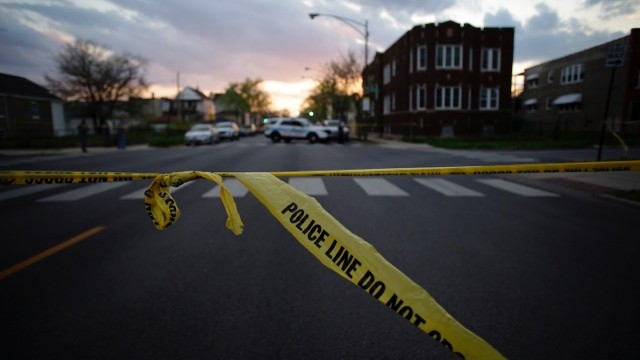New IPR Research: July and August 2023
Get all our news

This month’s new research covers studies examining the relationship between an individual’s COVID-19 vaccination status and their preferred news source, the impact of concerns about downward socioeconomic mobility on college students’ academic experiences, affordable "high-dosage" tutoring in high schools, two new measures of structural racism in schools, the role of parents in developing the racial identities of multiracial Black young adults, and community ideas to discourage gun violence.
Politics, Institutions, & Public Policy
News Source Impact on Vaccine Stance
Amidst the COVID-19 pandemic, there was a sharp division between those who supported vaccination and those who opposed and mistrusted it. In PNAS Nexus, IPR political scientist James Druckman and his colleagues seek to find the relationship between an individual’s vaccination status and their preferred news source for COVID-19 related information to determine how an individual’s news source influences their beliefs. About 20,000 participants were recruited for each of four rounds, which included an initial survey and a late survey, conducted from December 2020 to July 2021, using a technique to mirror the demographic composition of the United States. The survey asked about the individual’s vaccine status and if the individual had received COVID-19 related information in the past 24 hours from any of several news sources, including Facebook, Fox News, Newsmax, MSNBC, CNN, and the Biden or Trump Administration. The survey revealed that those who preferred to consult only Fox News and Facebook were more likely to be unvaccinated and more likely to distrust institutions. Additionally, those who relied on MSNBC or CNN, or the Biden Administration were significantly less likely to oppose vaccination and exhibited more trust in institutions. Based on these results, the researchers suggest that communication strategies to promote public health initiatives should consider where they direct their efforts when using social media. Druckman is the Payson S. Wild Professor of Political Science.
Education Policy
Concerns About Downward Mobility Among Students of Color
What impact do concerns about downward socioeconomic mobility have on college students’ academic experiences? IPR social psychologist Mesmin Destin, graduate research assistant Josiah Rosario, and their colleagues conduct two studies addressing this question in Social Psychology of Education. In their first study, the researchers found that when students had stronger concerns about the possibility of falling down the socioeconomic hierarchy during their lives, they also expressed more academic avoidance goals, which means that they were more focused on avoiding negative goals like bad grades than achieving positive goals like earning honors. This was especially true for students of color. In an experiment, the second study randomly assigned students to momentarily focus on the possibility of downward mobility, upward mobility, or a control condition. Building on the findings from the first study, students of color who were led to focus on downward mobility became more focused on avoidance goals than other students in the study. Prior research shows that over time, this type of sustained focus on avoiding mistakes rather than learning and improving can lead to lower effort, achievement, and well-being. The researchers conclude that broader societal risks of downward mobility for students of color can contribute to challenges that they face in pursuing their goals.
socioeconomic hierarchy during their lives, they also expressed more academic avoidance goals, which means that they were more focused on avoiding negative goals like bad grades than achieving positive goals like earning honors. This was especially true for students of color. In an experiment, the second study randomly assigned students to momentarily focus on the possibility of downward mobility, upward mobility, or a control condition. Building on the findings from the first study, students of color who were led to focus on downward mobility became more focused on avoidance goals than other students in the study. Prior research shows that over time, this type of sustained focus on avoiding mistakes rather than learning and improving can lead to lower effort, achievement, and well-being. The researchers conclude that broader societal risks of downward mobility for students of color can contribute to challenges that they face in pursuing their goals.
Affordable 'High-Dosage' Tutoring in High Schools
Can in-school tutoring be effective and affordable on a large scale? In the American Economic Review, IPR economist Jonathan Guryan and his colleagues explore intensive, in-school tutoring as a cost-effective intervention for high-school students who are behind academically. The researchers conducted two randomized controlled trials in Chicago Public Schools in 2013–14 and 2014–15 of Saga Education’s tutoring program, involving 2,633 and 2,645 ninth- and tenth-grade students, respectively. The program, which involves each tutor working with two students at a time for a full class period every day in addition to their regular math class, is integrated into the school day and uses paraprofessionals instead of full-time teachers, making it less costly. In the first trial, participating in the tutoring program caused student learning to increase by the equivalent of more than an additional year of learning, and in the second trial, tutoring generated even larger test score gains. Tutoring also raised grades and graduation rates for all students, who were also less likely to fail math and other courses. The cost for these beneficial outcomes is comparable to many successful early childhood programs, suggesting that effective tutoring may be affordable and scalable in traditional high schools. The research was supported by the National Institutes of Health, MacArthur Foundation, and Arnold Ventures. Guryan is Lawyer Taylor Professor of Education and Social Policy.
Poverty, Race & Inequality
The Role of Parents in Developing the Racial Identities of Multiracial Black Young Adults
Racial identity is a crucial part of identity development that is shaped by different environments, including the home. In Race and Social Problems, IPR graduate student Courtney Meiling Jones and IPR developmental psychologist Onnie Rogers explored the role parents play in Multiracial, Black young adults making meaning of their own racial identities. The researchers examined 11 semi-structured interviews of Multiracial Black college  students about race, racial identity, and the Black Lives Matter movement taken from the “Beyond Black and White” study. The researchers used the m(ai)cro model to focus on the role of the macrosystem in human development, allowing them to analyze the ways in which societal structures of power cannot be separated from the micro-level racial identities and socialization experiences of Multiracial youth. Similarly, the researchers relied on Critical Multiracial Theory (MultiCrit) to assess the distinct ways that the structure of white supremacy influences multiraciality and how this influence forms the everyday experiences and individual assessment of Multiracial people. The researchers find college students spontaneously mentioned their parents in the interviews as a source of racial information or guidance, as a way to support their own racial identification, and to illustrate how their Multiracial identities created moments of connection and disconnection with parents and family members. The findings underscore that parents play a pivotal role in helping Multiracial youth navigate their identities into the young adult years. Moreover, the young adults show us how parents of Multiracial young people can best support their children’s racial development, including by being aware of how their own racial identities as parents may support or constrain how their children are able to identify in the American racial context. Future research should continue to explore the role of families in socializing their children—especially Multiracial youth.
students about race, racial identity, and the Black Lives Matter movement taken from the “Beyond Black and White” study. The researchers used the m(ai)cro model to focus on the role of the macrosystem in human development, allowing them to analyze the ways in which societal structures of power cannot be separated from the micro-level racial identities and socialization experiences of Multiracial youth. Similarly, the researchers relied on Critical Multiracial Theory (MultiCrit) to assess the distinct ways that the structure of white supremacy influences multiraciality and how this influence forms the everyday experiences and individual assessment of Multiracial people. The researchers find college students spontaneously mentioned their parents in the interviews as a source of racial information or guidance, as a way to support their own racial identification, and to illustrate how their Multiracial identities created moments of connection and disconnection with parents and family members. The findings underscore that parents play a pivotal role in helping Multiracial youth navigate their identities into the young adult years. Moreover, the young adults show us how parents of Multiracial young people can best support their children’s racial development, including by being aware of how their own racial identities as parents may support or constrain how their children are able to identify in the American racial context. Future research should continue to explore the role of families in socializing their children—especially Multiracial youth.
Two New Measures of Structural Racism in Schools
Previous research shows that encountering racism from others predicts poor physical and mental health, but scholars are still working to measure the effects of structural racism on health. In SSM – Population Health, IPR anthropologist Thomas McDade, former postdoctoral fellows Jessica Polos and Stephanie Koning, and their colleagues take a biosocial perspective to analyze survey data from the National Longitudinal Study of Adolescent to Adult Health. They create two indices of structural racism in schools, focusing on a representative sample of over 12,000 students aged 11–21 who were surveyed in 1994–95. The researchers’ first measure, a school contextual disadvantage index (CDI), captures resources and opportunities across schools, thus including historic concentration of Black students in more disadvantaged schools. The second, the school structural racism index (SRI), compares Black and White students’ shares of resources and opportunities within schools. As a final step, the researchers relate the indices to depression in adolescents. The findings demonstrate that Black students were more than twice as likely to attend schools with higher CDI levels compared to White students. Increases in CDI were linked to increased depressive symptoms among all students, but the increase was highest among Black girls. Separately, exposure to racism within school, measured by the SDI, is associated with more depressive symptoms in Black boys and girls. This means that Black youth at more advantaged schools, which tend to have lower percentages of Black students, are at a higher risk of depression. McDade is the Carlos Montezuma Professor of Anthropology.
Urban Policy and Community Development
Community Ideas to Discourage Gun Violence
There were 20,138 firearm deaths that occurred in the United States in 2022, with gun violence disproportionately affecting people of color. In SSM - Qualitative Research in Health, IPR sociologist Andrew Papachristos and his colleagues examine community opinions on local assets that might discourage gun violence. They identified 45 individuals, 33% of them Black, 32% of them White, and 27% of them Hispanic, located in New Haven, Connecticut, who were not directly affected by gun violence, despite having a high likelihood of being involved as a shooter or victim in gun violence. The researchers interviewed them about what social structures they thought could deter gun violence locally. For example, the researchers asked, “Can you provide specific examples of how you and your neighbors have worked to reduce gun violence on your block/street?” From these interviews, the researchers determine that the community members thought that gun violence could be discouraged on interpersonal, neighborhood, and organizational levels by encouraging role models, social cohesion, home ownership, and community-based organizations. The researchers suggest investment in stable housing, efforts to foster social cohesion, access to mental health support, and youth activities to deter gun violence.
could deter gun violence locally. For example, the researchers asked, “Can you provide specific examples of how you and your neighbors have worked to reduce gun violence on your block/street?” From these interviews, the researchers determine that the community members thought that gun violence could be discouraged on interpersonal, neighborhood, and organizational levels by encouraging role models, social cohesion, home ownership, and community-based organizations. The researchers suggest investment in stable housing, efforts to foster social cohesion, access to mental health support, and youth activities to deter gun violence.
Photo credits: Unsplash and Pexels
Published: August 2, 2023.


